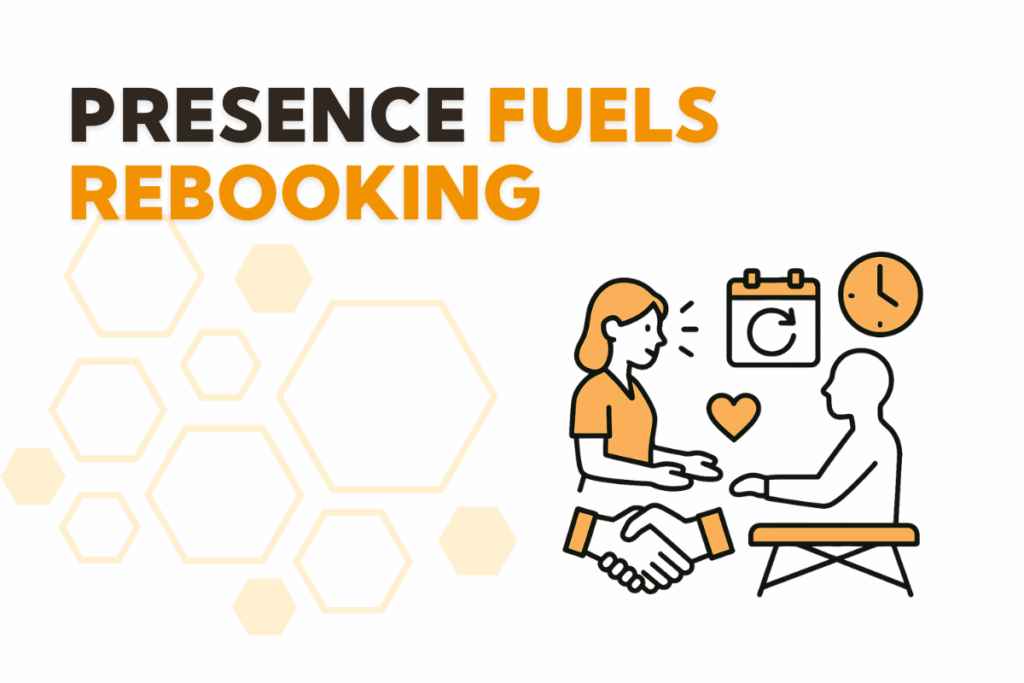Automation morale drop is a real problem clinic owners feel fast. If an automation morale drop hits your team, you can fix it without slowing the week. When a task someone loved is automated, the schedule speeds up yet the day feels thin. The first signs often appear inside two weeks as the lobby grows quieter, rebooking softens, and notes lose color. Here is how to keep your gains and restore the meaning that keeps people proud of their work.
When faster makes the day feel thin
An automation morale drop often begins quietly. The teammate who once energized the room now does only what is required. Clients move smoothly through check in, but the welcome feels generic. This shift is not only operational. It is the loss of a small ritual that carried identity and connection, like greeting by name or adding a personal note after a tough week.
Why removing a loved task dents pride and performance
The psychology you can use right now
Meaningful work and ownership
People shape certain tasks to express craft and care. Remove that canvas and energy drops. The fix is not to reverse the tool. The fix is to give the meaning a new home that people can own.
Autonomy, competence, relatedness
Therapists thrive when they have choice, mastery, and belonging. If automation erases ownership or voice, those needs go unmet. That is the human engine behind an automation morale drop.
Where you will see it in your numbers
Rebooking and conversion
Client experience and loyalty move together. When warmth fades, first to second visit conversion usually dips, even if throughput improves.
Review language
Read open text comments for early signals. When “felt seen,” “personal,” and “warm welcome” show up less often, presence is slipping and an automation morale drop may be underway.
Read the room with measures that matter
Two questions for your next huddle
What felt thin and what felt like care
Ask the team where the day felt thin and which moment still felt like real care. Capture their words. You are mapping meaning, not features. This short step shows respect and starts the repair.
One presence metric to keep you honest
A small behavior you will protect
Choose one visible behavior to count, such as a two minute start in the room, a clear consent check, or a short “clinician voice” note for nuance. When this grows, the room usually feels better and the automation morale drop begins to lift.
Map the meaning before you fix the steps
A quick process that fits the week
Three questions to anchor the redesign
What did the old task let you express. Where in the client journey do we still need that meaning. Who wants to own the new version of it. Use these answers to shape the next step so the repair targets the cause, not the symptom of an automation morale drop.

Design automation that protects presence
If you added self check in
Turn saved minutes into a warmer start
Protect the first two minutes in the room. Greet by name, share one breath, confirm consent, and connect today to the last visit. Assign clear ownership so a person, not a tablet, still owns the welcome.
If you templated SOAP notes
Keep speed and restore voice
Add a small “clinician voice” field for nuance. Read one standout line in a weekly huddle. Pride returns without losing efficiency and the automation morale drop eases.
If reminders went fully automated
Add a human touch where risk is higher
Open a short morning window for call backs to post injury, prenatal, or post op clients. One caring call protects relationship capital and reduces silent churn.
Change with the team, not to the team
Co design that earns trust
Involve the people who did the work
Invite the staff who owned the original task to co design the fix. When people shape the change, resistance falls and adoption rises. This is the fastest way to turn an automation morale drop into a learning win.
Micro pilots with real rollbacks
Two weeks, two volunteers, clear success
Run a two week pilot, define success up front, and promise a real rollback if warmth does not stabilize. Close the loop in a live huddle so everyone sees the outcome.
Your scoreboard: speed and warmth on the same page
What you should watch together
Efficiency beside connection
Time saved per visit, no show rate, and error rate belong next to rebooking percent, first to second visit conversion, and the frequency of warmth words in reviews. When both sides move together, your fix is working and the automation morale drop is ending.
Make the data easy to see
Simple tools that keep focus on behavior
Visualize both sides of the scoreboard in one view. A clear dashboard helps teams act quickly. If you want a practical way to see trends, connect to massage clinic reporting analytics and schedule a weekly summary through massage clinic business automation so the team can react while the signals are still fresh.
Scripts that rebuild trust fast
What to say to the team
Acknowledgement that opens the door
“We sped up a task many of you cared about. I see the efficiency and I see the thin spots. Let us keep the speed and bring back the meaning together.”
What to ask in one to ones
Questions that surface ownership
“What part of that task felt like your signature of care.”
“Where should that meaning live now, and what would you like to own.”
“What small change this week would make your day feel like your best work.”
What to tell clients
A line that explains the change
“Check in is quicker so we can spend those saved minutes on a warmer start in the room.”

Two clinic vignettes you can use this month
Self check in with a softer lobby
A small ritual that steadied rebooking
A clinic added tablets and saved three minutes per arrival. The lobby felt flat. They introduced a two minute room welcome and kept eye contact scanning at the front. Rebooking steadied within two weeks. The team felt essential again and the automation morale drop faded.
Templates with quieter notes
One field that restored pride
Documentation sped up but handoffs lost nuance. The lead added a “clinician voice” box and shared one strong line each week. Speed stayed. Pride returned. The automation morale drop lifted without throwing out the templates.
Guardrails for future changes
Three questions before go live
A quick readiness check
Is this an identity task for anyone. What care signal or social glue does it carry. Where will that meaning live after the change, and who owns it. If you cannot answer all three, delay the rollout and prevent a fresh automation morale drop.
A rollout path that protects warmth
Steps that fit a busy clinic
Host a short co design huddle, run a two week pilot with clear success markers, define and display one presence metric, name an owner for the new ritual, and debrief live on day fourteen with a go, tweak, or roll back decision.
What to do next
A 30 day plan that brings the room back
This week, run the meaning map and choose one ritual to restore. For the next two weeks, protect it and make it visible. In week four, review rebooking, first to second visit conversion, and your presence metric together. Most clinics feel the room return before the month ends. For background on why experience links to outcomes, see this summary from BMJ Open: https://bmjopen.bmj.com/content/3/1/e001570.
FAQs
A favorite task often carried identity and connection. When automation removed ownership or voice, basic needs for choice, mastery, and belonging were left unmet. That is the root of an automation morale drop.
Protect a two minute start in the room with a greeting by name, a shared breath, a consent check, and one link to the last visit. This visible care signal often reverses an automation morale drop.
Two weeks is enough for early signals. Watch rebooking, first to second visit conversion, and your presence metric. If warmth does not stabilize, adjust or roll back. This keeps an automation morale drop from sticking.
Invite two volunteers to shape the fix, publish the success criteria, and promise a real debrief on day fourteen. When people help design the path, they move faster. This shared ownership is the surest way to resolve an automation morale drop.


